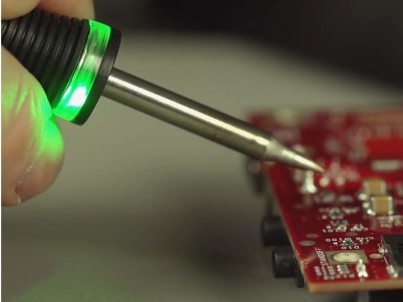The end of the cold solder joint
November 16, 2017
on
on
The intermetallic compound (IMC) thickness is a key parameter for determining the quality of a solder joint. When it is too thin, less than about 0.25 µm, the joint is “cold”; when it is too thick, 4 µm and more, it is brittle. The optimum IMC thickness is around 1 µm.

Placing the soldering iron’s tip on the joint to solder creates a power demand, indicating the beginning of a solder event. The system monitors the power demand until a change is detected, indicating the completion of the thermal bridge. At this point the solder has become completely fluid.
The system now calculates the intermetallic compound (IMC) thickness as a function of temperature and time. The cartridge (“soldering iron”) lights up green when the correct IMC thickness of about 1 µm has formed. Any error occurring during the process is signalled by a red light.
Update from Elektor Editor Jan Buiting: @ productronica 2017 in Munich. I personally tested the system. The result: perfect solder joints for SMD as well as TH parts. This thing is packed with parameters and intelligence.
Solder joint quality
Currently the quality of solder joints is mainly determined by visual inspection but Metcal has developed a method to make the soldering iron do it instead. Connection Validation (CV), as the technique is called, provides immediate visual feedback about the quality of the solder joint during soldering.
Placing the soldering iron’s tip on the joint to solder creates a power demand, indicating the beginning of a solder event. The system monitors the power demand until a change is detected, indicating the completion of the thermal bridge. At this point the solder has become completely fluid.
The system now calculates the intermetallic compound (IMC) thickness as a function of temperature and time. The cartridge (“soldering iron”) lights up green when the correct IMC thickness of about 1 µm has formed. Any error occurring during the process is signalled by a red light.
Update from Elektor Editor Jan Buiting: @ productronica 2017 in Munich. I personally tested the system. The result: perfect solder joints for SMD as well as TH parts. This thing is packed with parameters and intelligence.
Read full article
Hide full article


Discussion (3 comments)